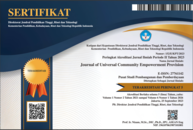Education through the Approach to Using Regional Languages on the Level of Community Understanding Related to the Covid-19 Vaccine in Tabumela Village, Tilango District Gorontalo
DOI:
https://doi.org/10.55885/jucep.v1i2.71Keywords:
Regional Language, Society, Covid-19 VaccineAbstract
Language is the most prominent distinguishing feature because with language each social group feels itself as a different unit from other groups, where society is a group of people who live together in an area and then form a system. COVID-19 is a disease caused by (SARS-CoV2), which can cause symptoms such as fever, headache, muscle aches, impaired smell, decreased taste, sore throat, respiratory problems, nausea/vomiting/abdominal pain, other symptoms according to organs. Thus, what we have to do to prevent the spread can be done by giving vaccines. COVID-19 vaccination is an important part of efforts to handle the COVID-19 pandemic which is comprehensive and integrated, covering aspects of prevention by implementing health protocols: keeping distance, washing hands with soap and wearing masks (3M), COVID-19 vaccination, and 3T (Test, Search, Follow up). Based on the results of the training, it showed that most of the people stated that this education was very useful because they gained knowledge and understanding regarding the covid-19 vaccine in using the local language
References
Glăveanu, V. P. (2010). Principles for a cultural psychology of creativity.Culture & Psychology,16(2), 147-163.
Liu, C., Zhou, Q., Li, Y., Garner, L. V., Watkins, S. P., Carter, L. J., ... & Albaiu, D. (2020). Research and development on therapeutic agents and vaccines for COVID-19 and related human coronavirus diseases.
Liu, C., Zhou, Q., Li, Y., Garner, L. V., Watkins, S. P., Carter, L. J., ... & Albaiu, D. (2020). Research and development on therapeutic agents and vaccines for COVID-19 and related humancoronavirus diseases.
Lurie, N., Melanie S., Richard H., dan Jane H. (2020). Developing Covid-19 Vaccines at Pandemic Speed. The New England Journal of Medicine: Perspective, 1-5. https://doi.org/10.1056/NEJMp2005630
Meeusen, E. N., Walker, J., Peters, A., Pastoret, P. P., & Jungersen, G. (2007). Current status of veterinary vaccines. Clinical microbiology reviews, 20(3), 489-510.
Panhwar, A. H., Ansari, S., & Ansari, K. (2016). Sociocultural theory and its role in the development of language pedagogy.Advances in language and literary studies, 7(6), 183-188.
Slovic, P., Finucane, M. L., Peters, E., & MacGregor, D. G. (2013). Risk as analysis and risk as feelings: Some thoughts about affect, reason, risk and rationality. InThe Feeling of Risk (pp. 49-64). Routledge.
Turiel, E. (2006). Thought, emotions, and social interactional processes in moral development.Handbook of moral development, 2.
Van Kleef, G. A. (2009). How emotions regulate social life: The emotions as social information (EASI) model.Current directions in psychological science,18(3), 184-188.
Downloads
Published
How to Cite
Issue
Section
License
Copyright (c) 2021 Journal of Universal Community Empowerment Provision

This work is licensed under a Creative Commons Attribution-ShareAlike 4.0 International License.
















